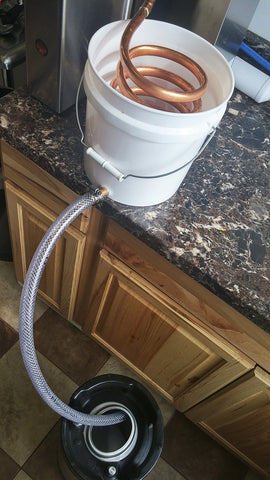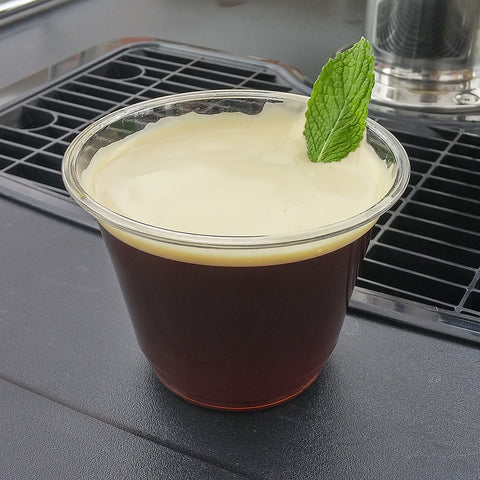UPDATE: We've updated this guide with our current method -- check it out right here!
Quick version: We ditched the coil and are chilling in an immersion bath.
Nitro coffee is so hot right now - and with good reason. The addition of nitrogen to a cold coffee does wonders for its texture, mouthfeel, and an impression of creaminess. It puts back in what is often lacking in cold coffee - body and mouthfeel. It's also beautiful -- a gentle cascade of tiny nitrogen bubbles, and a thick, micro-foam like head give the drinker a positive impression before they ever take a sip. And that sip, contrasted against other cold-coffee methods, can be downright sublime.
There are a lot of questions out there surrounding how to make nitro coffee, so we thought a guide might be helpful to some. This is how we make our nitro coffee, and some of the hurdles we had to overcome to create it.
Please note, because of our altitude and a boiling point of about 198F, we use slightly lower brewing temps and ratios than SCAA standards, which are set at sea-level.
 Heavy cascade, thick head. Nitro the H+S way.
Heavy cascade, thick head. Nitro the H+S way.
Brew Method
First, a word on brew methods. Coffee has a "fingerprint" from when the seed gets planted, all the way through the finished cup, and each step in the process can only take away from that fingerprint. As a roaster, we keep that in mind as one of the last links in the chain between the seed and the cup. We try to roast our single origins to highlight that fingerprint and try prevent diminishing it as much as possible. Likewise, when brewing our nitro coffee, we want to keep as much of that fingerprint intact. And that means brewing hot.
Brewing hot - advantages
- Brewing coffee hot provides a much larger flavor matrix -- one that encompasses acidity, sweetness, body, and many other sensations on the palette. Brewing hot allows acids to present beautiful, clean, sparkling qualities to the cup.
- Brewing hot allows a higher ratio of water to coffee to hit the same target TDS as cold brewing, making it more efficient from the perspective of coffee usage (although time & labor make hot brewing less efficient from that perspective).
- Brewing hot allows easier paper filtering -- something we have found to be incredibly important for a good nitro coffee. More on this later.
Brewing hot - disadvantages
- Time & labor - brewing hot is much more time and labor intensive than cold brewing.
- Scale - how do we scale this up for large production runs?
- Cooling down - we need cold nitro coffee!
Brewing cold - advantages
- Scale - cold brewing can be done one a large scale very easily. Giant advantage. We could brew a 5 gallon keg of cold-brew in a tenth of the labor time as brewing hot.
- Speed - set and forget. Coffee goes in a cloth filter bag. Add water. The next day, pull out the filter bag. The cold brew is ready!
- Equipment - a bucket, a lid, and a filter.
- Already cold - and that's what we want, right?
Brewing cold - disadvantages
- Flavor matrix - as we stated, we don't cold brew because we just miss a lot of the compounds which only get extracted with hot water, and therefore the potential array of flavors.
- Ratio - it takes a lot more coffee to water to produce a cold brew that's worth drinking. We've found a TDS of roughly double the SCAA recommended (2.5-2.7 TDS) produces an acceptable cold-brew. We hit that with ratios between 1:8 and 1:10 depending on time/temperature. We also went as low as 1:5 in pursuit of ultra-big bodied cold brew.
- Filter method - While cloth filtering is easy, it allows a bunch of superfines and, most importantly - oils, into the finished beverage. And because of high ratios, there's more of those than in a standard hot extraction, and that alters the flavor dynamic of the coffee. So why not paper filter cold-brew? Because it takes forever, that's why. Superfines from cold-brew will plug up a paper filter to a very slow drip. (We went so far as to try a paper filter with pressure via an aeropress. I'm sure there are better methods out there!)
- Balance - cold-brew is unbalanced. How often have you sipped one and thought, "somethings missing"?
A word on oils and superfines, and the biggest reason we paper filter:
Oil breaks head retention. When we were developing our nitro aspirations, we sought insight from a local brewmaster. He helped us a TON throughout the process. One of his biggest insights was that oils disrupt the formation of that classic "nitro head." This tidbit would later unlock the revelation that we needed to paper filter our coffee to get as much of those oils out.
This is one of the key aspects of H+S nitro coffee. You will get a beautiful, thick, creamy head if you paper filter for nitro coffee.
Our brew method:
Okay, we've gone over a lot already. Let's tie it together a bit better by going over the proof-of-concept equipment we used to unlock great nitro coffee.
- Brewer - anything that can provide a stable, consistent temperature. We used a Fetco CBS 2031, single group 3L brewer.
- Flash chiller - we have to get that hot coffee cold as fast as possible. Enter a piece of beer-brewing equipment: the wort chiller. There are a variety of wort chillers and flash-chilling styles that seem to work well for coffee. We like the idea of the counterflow chiller, but for our experiments we built an "inverted immersion chiller" -- coffee runs through a copper coil which is immersed in an ice bath. The coil is gravity-fed directly from the bottom of the brew basket, through the coil in the ice bath, and directly into the keg.

- Keg - at our small scale it seems like a Corny keg is ideal. The ability to prime the nitro though the coffee and allow air to escape via the release valve will the keep coffee flavor stable for longer. We don't have experience with nitrogenating Sanke kegs.
- Nitrogen - 100% nitrogen is required. Beergas will not work. CO2 is the enemy of brewed coffee and introducing it into the coffee will spoil it instantly. Carbonated coffee is full of Carbonic acid, which is bitter and awful in conjunction with coffee. Stay away!
- Stout faucet - We've actually not tested with a traditional faucet, so we can only say we've used a stout faucet with a restrictor plate with fantastic results.
Brewing a full keg
- Ratio - cold coffee and hot coffee imbue a different perception on the palette. All those compounds taste different at different temperatures. So we don't really know what the "ideal" extraction strength is for flash-chilled coffee, besides which taste is completely subjective. But we have a feeling that a slightly stronger extraction tastes slightly better when flash-chilled, so we use around 1:14 ratio for our brewing and a target TDS of 1.45-1.5
- Temperature - Brew at the same temperature you would hot coffee. The flash-chilling device we built took coffee from 195 to about 70 degrees across the duration of one batch (3L output).

- Conditioning - Once we have a full keg, it's time to prime it for serving. To do this, introduce nitrogen at a very light pressure (2-3 psi) though the Corny keg outlet valve. Open the safety valve to let air out while nitrogen is going in. Because nitrogen is lighter than air, our hope is that applying the nitrogen though the bottom of the keg will help air escape via the safety valve. After a few seconds, close the safety valve and continue to introduce about 30-40 psi, via the outlet valve, into the keg. Now the keg is conditioned. Rock the keg across your knee about 20 times, and the keg is ready for the final chill.
- Serving - Once the keg has finished cooling to 35-40 degrees, it's ready for serving. Hook up the keg lines to the correct valves this time, then serve via a stout faucet. The hot brewed, flash chilled, nitro conditioned coffee will have a huge amount of flavor, added mouthfeel and body due to the nitrogen, and will look fantastic with a full cascade and a thick, creamy head.

